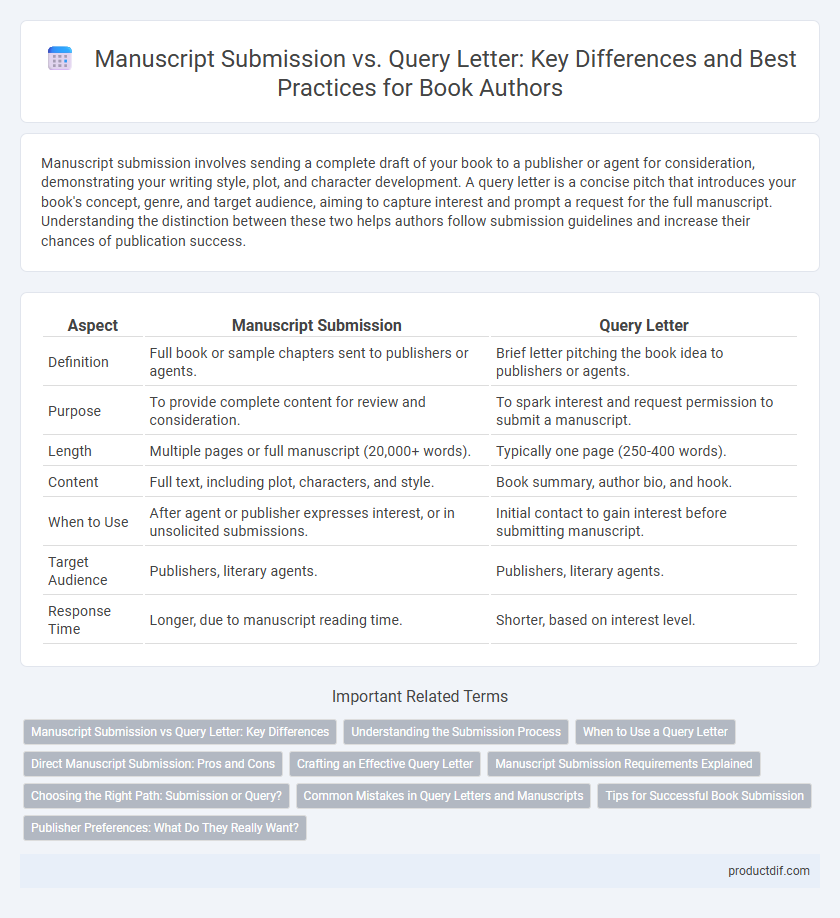Manuscript submission involves sending a complete draft of your book to a publisher or agent for consideration, demonstrating your writing style, plot, and character development. A query letter is a concise pitch that introduces your book's concept, genre, and target audience, aiming to capture interest and prompt a request for the full manuscript. Understanding the distinction between these two helps authors follow submission guidelines and increase their chances of publication success.
Table of Comparison
| Aspect | Manuscript Submission | Query Letter |
|---|---|---|
| Definition | Full book or sample chapters sent to publishers or agents. | Brief letter pitching the book idea to publishers or agents. |
| Purpose | To provide complete content for review and consideration. | To spark interest and request permission to submit a manuscript. |
| Length | Multiple pages or full manuscript (20,000+ words). | Typically one page (250-400 words). |
| Content | Full text, including plot, characters, and style. | Book summary, author bio, and hook. |
| When to Use | After agent or publisher expresses interest, or in unsolicited submissions. | Initial contact to gain interest before submitting manuscript. |
| Target Audience | Publishers, literary agents. | Publishers, literary agents. |
| Response Time | Longer, due to manuscript reading time. | Shorter, based on interest level. |
Manuscript Submission vs Query Letter: Key Differences
Manuscript submission involves sending the complete written work to publishers or literary agents for review, while a query letter is a concise proposal highlighting the book's concept and author credentials. Manuscript submission allows direct evaluation of the text's content and style, whereas query letters serve to gauge initial interest and secure a request for the full manuscript. Understanding these key differences helps authors strategically approach the publishing process.
Understanding the Submission Process
Manuscript submission involves sending a complete or partial work directly to publishers or literary agents, requiring adherence to specific formatting and guidelines. Query letters serve as a concise pitch, introducing the author and the manuscript's premise to capture interest before any full submission. Understanding the distinction between these steps streamlines the submission process and increases the chances of a successful publishing opportunity.
When to Use a Query Letter
A query letter should be used when approaching literary agents or publishers to propose a book concept before submitting a full manuscript. It serves as a concise pitch highlighting the book's genre, plot synopsis, target audience, and author credentials to spark interest. Query letters are typically employed in the early stages of the publishing process, whereas manuscript submissions follow only after an agent or publisher requests the complete work.
Direct Manuscript Submission: Pros and Cons
Direct manuscript submission allows authors to present their complete work to publishers or agents, increasing the chance of immediate evaluation based on the full content rather than just a synopsis. This approach can expedite the publishing process but often requires adherence to strict formatting guidelines and readiness for detailed feedback. However, it may limit exposure if the manuscript does not match the publisher's specific interests, compared to query letters that gauge interest before submitting the full text.
Crafting an Effective Query Letter
Crafting an effective query letter requires clear, concise communication that highlights the manuscript's unique plot, genre, and target audience. Writers should include a compelling hook, a brief synopsis of the manuscript, and author credentials to capture an agent's interest. Tailoring each query letter to specific agents or publishers based on submission guidelines enhances the chances of successful manuscript consideration.
Manuscript Submission Requirements Explained
Manuscript submission requires a complete, properly formatted document often including a title page, synopsis, and author biography, ensuring it aligns with the publisher's specific guidelines. Query letters typically serve as a brief introduction to the manuscript, highlighting the book's premise and author credentials without including the full text. Understanding precise submission requirements, such as word count, file format, and accompanying materials, is crucial for successful manuscript consideration in the publishing process.
Choosing the Right Path: Submission or Query?
Manuscript submission involves sending a complete draft to agents or publishers, ideal for those confident in their polished work and seeking direct evaluation. Query letters serve as a concise introduction, pitching the book concept to gauge interest before submitting the full manuscript, which helps filter targeted opportunities. Writers must assess their readiness and the specific requirements of publishers to choose the path that maximizes their manuscript's potential for acceptance.
Common Mistakes in Query Letters and Manuscripts
Common mistakes in query letters include failing to personalize the pitch, omitting a concise synopsis, and neglecting to research the agent or publisher's submission guidelines. Manuscript errors often involve poor formatting, inconsistent tense usage, and weak character development that undermines narrative coherence. Both elements require careful attention to detail to enhance the chances of acceptance in the competitive publishing industry.
Tips for Successful Book Submission
Manuscript submission requires a complete and polished draft, demonstrating your writing skills and story potential to publishers or agents. Query letters must be concise, clearly presenting the book's genre, unique premise, and your author credentials to capture interest quickly. Tailor each query or manuscript package to the specific guidelines of the target publisher or agent for higher chances of success.
Publisher Preferences: What Do They Really Want?
Publishers prioritize manuscript submissions when they require a complete and polished manuscript to evaluate the writing, plot, and style comprehensively. Query letters are preferred by many agents and smaller publishers who seek a concise pitch to quickly assess a book's potential and marketability. Understanding specific publisher submission guidelines, often detailed on their websites, ensures authors meet expectations and increase chances of consideration.
Manuscript Submission vs Query Letter Infographic

 productdif.com
productdif.com